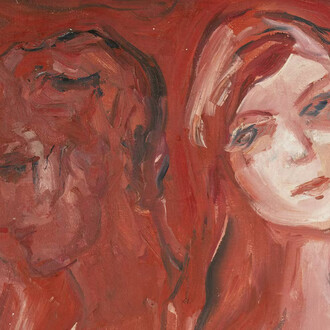In Através [Through], the artist Marco Giannotti (São Paulo, SP – 1966) presents paintings and reliefs that deal with the relationship between drawing and color in Western painting since the Renaissance. Curated by Agnaldo Farias, the show features a new group of about 20 artworks in which Giannotti uses schemas of perspectives in counterpoint to a varying chromatic spectrum, applied in various techniques such as oil painting, tempera and enamel with graffiti. The perspective indicates a way of showing and reconstructing a city. “Currently, various perspectives can be laid out with the new technologies: Através is the place where the artist gives free rein to his imagination,” says Giannotti. For him, the spaces also allude to fragments of ideal or utopian cities that are sometimes labyrinthine and atemporal. “The projective dimension of the works thus opens possibilities for reflecting on the place of the painting in the contemporary world, where the virtual space is increasingly overlaid to the real space,” he concludes.
According to Agnaldo Farias, “These paintings by Giannotti are in step with this orientation: they are occupied by twisted grids, airy architectures, apparent tunnels with digital graphic constructions, funneling toward small square areas of escape, modules that become small-scale due to their distance; there are also more radical cases, canvases composed by divergent compositions, some based on counterpoints of perspectives, others on disordered superpositions, all of them unstable, unquiet, noisy productions,” the curator adds.
Since he is also a professor and translator, Giannotti’s work reflects on his nature as a scholar and researcher. In this series of works that composes the exhibition Através, he focused on the studioli of Urbino and Gubbio, where important studies of perspectives and philosophy were carried out during the Italian Renaissance. In his previous exhibition at Galeria Raquel Arnaud, Penumbra, he investigated the point of transition between light and shadow, reconsidering questions in his master’s thesis in philosophy, for which he translated part of Goethe’s Theory of Colors, and analyzed the work In Praise of Shadows, by Junichiro Tanizaki. In Diários de Kioto, a solo show held at Instituto Tomie Ohtake in 2013, the delicate collages on washi paper were based on his travel notebook, conceived during his stay in the city, in 2011, when he delved into Japanese culture while giving classes at the Kyoto University of Foreign Studies.
Marco Giannotti is a painter and professor with the School of Communication and Arts of USP. From 1977 to 1980, Giannotti attended the studio of Sérgio Fingermann, where he learned drawing and metal engraving. Between 1980 and 1982, he took art courses at the Metropolitan Museum of Art in New York. After returning to Brazil, he participated in the IX and X Salões Nacionais de Artes Plásticas in São Paulo, winning the acquisition prize. In 1987, he received the Ivan Serpa grant, from FUNARTE, and in 1988 he held his first solo show at Galeria Paulo Figueiredo. Also in 1988 he graduated in social sciences from the College of Philosophy, Letters and Human Sciences of the Universidade de São Paulo. In 1993, he earned his MA in philosophy at FFLCH/USP, for which he translated Goethe’s Theory of Colors and his wrote a critical introduction to this work. That same year, he held a solo show at MASP entitled Fachadas.
He has participated in important national exhibitions including: Arte Contemporânea São Paulo: perspectivas recentes, at Centro Cultural São Paulo in 1989, the Panorama da Arte Atual Brasileira, at the Museu de Arte Moderna de São Paulo in 1990 and 1993, Arte/Cidade: cidade sem janelas in 1994 and Artecidadezonaleste in 2002, as well as international exhibitions such as the II and III Bienal do Mercosul in 1999 and 2001, the Bienal de Cuenca in Ecuador in 1987, Brazil Projects 90, at the Municipal Art Gallery, in Los Angeles, in 1990, Arte Contemporânea Brasileira, at Liljevaclchs Konstahall, in Stockholm, in 1991, and Quase Nada, at the Cultural Center of Wiesbaden, in Germany.
In 1997, he received the painting prize of the Associação Paulista dos Críticos de Arte (APCA). In 2007, he held a solo show at the Pinacoteca do Estado and released the book Passagens, published by Cosac Naify. In 2008, he joined the roster of artists represented by Galeria Raquel Arnaud, where he presented, in 2009, the series Contraluz. In 2010, he held the exhibition Arte e Espiritualidade at the São Bento Monastery in partnership with José Spaniol and Carlos Uchoa, chosen as the best exhibition of the year by the APCA. In 2011, the Spanish publishing house Dardo published a new anthology of his recent works, with texts by David Barro and Ronaldo Brito.
In 2008, Marco Giannotti was a visiting professor at Yale, and from March 2011 to March 2012 he taught at the Kyoto University of Foreign Studies. After that period of intense research on Japanese culture, in 2013 the artist published the book Diário de Kioto (WMF Martins Fontes, with support from the Embassy of Brazil in Japan). In 2013, he held his second solo show at the new facilities of Galeria Raquel Arnaud, Penumbra. Currently, Marco Giannotti is giving classes at the School of Communication and Arts (ECA) of the Universidade de São Paulo, where he coordinates the chromatic research group and is the president of the Commission on International Relations.
















